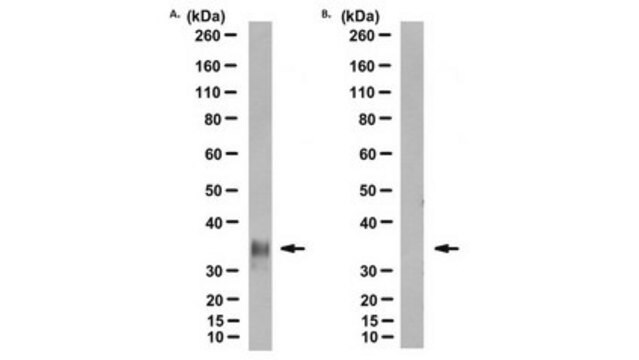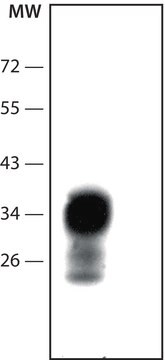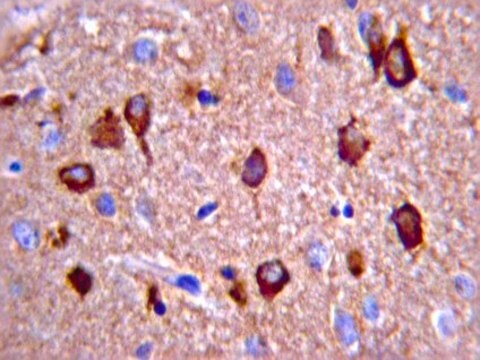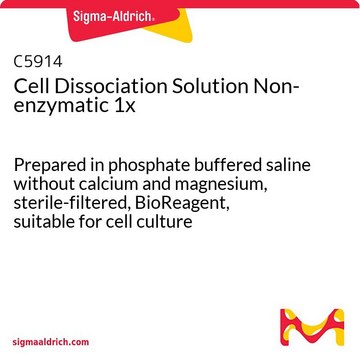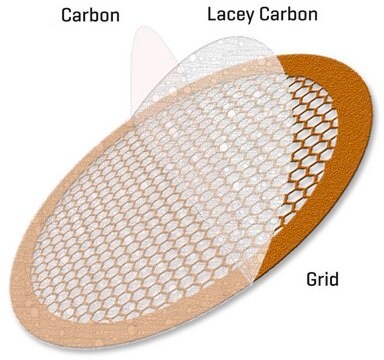MABN2285M
Anti-Prion Protein Antibody, clone POM1
clone POM1, from mouse
Synonim(y):
Major prion protein, PrP, PrP27-30, PrP33-35C, CD230
About This Item
Polecane produkty
pochodzenie biologiczne
mouse
Poziom jakości
forma przeciwciała
purified immunoglobulin
rodzaj przeciwciała
primary antibodies
klon
POM1, monoclonal
reaktywność gatunkowa
mouse, human
opakowanie
antibody small pack of 25 μg
metody
immunofluorescence: suitable
immunohistochemistry: suitable
immunoprecipitation (IP): suitable
western blot: suitable
izotyp
IgG1κ
numer dostępu NCBI
numer dostępu UniProt
docelowa modyfikacja potranslacyjna
unmodified
informacje o genach
mouse ... Prnp(19122)
Opis ogólny
Specyficzność
Immunogen
Zastosowanie
Neuroscience
Immunofluorescence Analysis: A representative lot detected Prion Protein in Immunofluorescence applications (Kuffer, A., et. al. (2016). Nature. 536(7617):464-8).
Immunohistochemistry Analysis: A representative lot detected Prion Protein in Immunohistochemistry applications (Polymenidou, M., et. al. (2008). PLoS One. 3(12):e3872).
Immunoprecipitation Analysis: A representative lot detected Prion Protein in Immunoprecipitation applications (Polymenidou, M., et. al. (2008). PLoS One. 3(12):e3872).
ELISA Analysis: A representative lot detected Prion Protein in ELISA applications (Polymenidou, M., et. al. (2008). PLoS One. 3(12):e3872).
Jakość
Western Blotting Analysis: 0.5 µg/mL of this antibody this antibody detected PrP in Brain homogenate from a Tga20 mouse overexpressing Prnp versus brain homogenate from a ZH3/ZH3 control mouse lacking Prnp.
Opis wartości docelowych
Postać fizyczna
Przechowywanie i stabilność
Inne uwagi
Oświadczenie o zrzeczeniu się odpowiedzialności
Nie możesz znaleźć właściwego produktu?
Wypróbuj nasz Narzędzie selektora produktów.
Kod klasy składowania
12 - Non Combustible Liquids
Klasa zagrożenia wodnego (WGK)
WGK 1
Temperatura zapłonu (°F)
Not applicable
Temperatura zapłonu (°C)
Not applicable
Certyfikaty analizy (CoA)
Poszukaj Certyfikaty analizy (CoA), wpisując numer partii/serii produktów. Numery serii i partii można znaleźć na etykiecie produktu po słowach „seria” lub „partia”.
Masz już ten produkt?
Dokumenty związane z niedawno zakupionymi produktami zostały zamieszczone w Bibliotece dokumentów.
Nasz zespół naukowców ma doświadczenie we wszystkich obszarach badań, w tym w naukach przyrodniczych, materiałoznawstwie, syntezie chemicznej, chromatografii, analityce i wielu innych dziedzinach.
Skontaktuj się z zespołem ds. pomocy technicznej